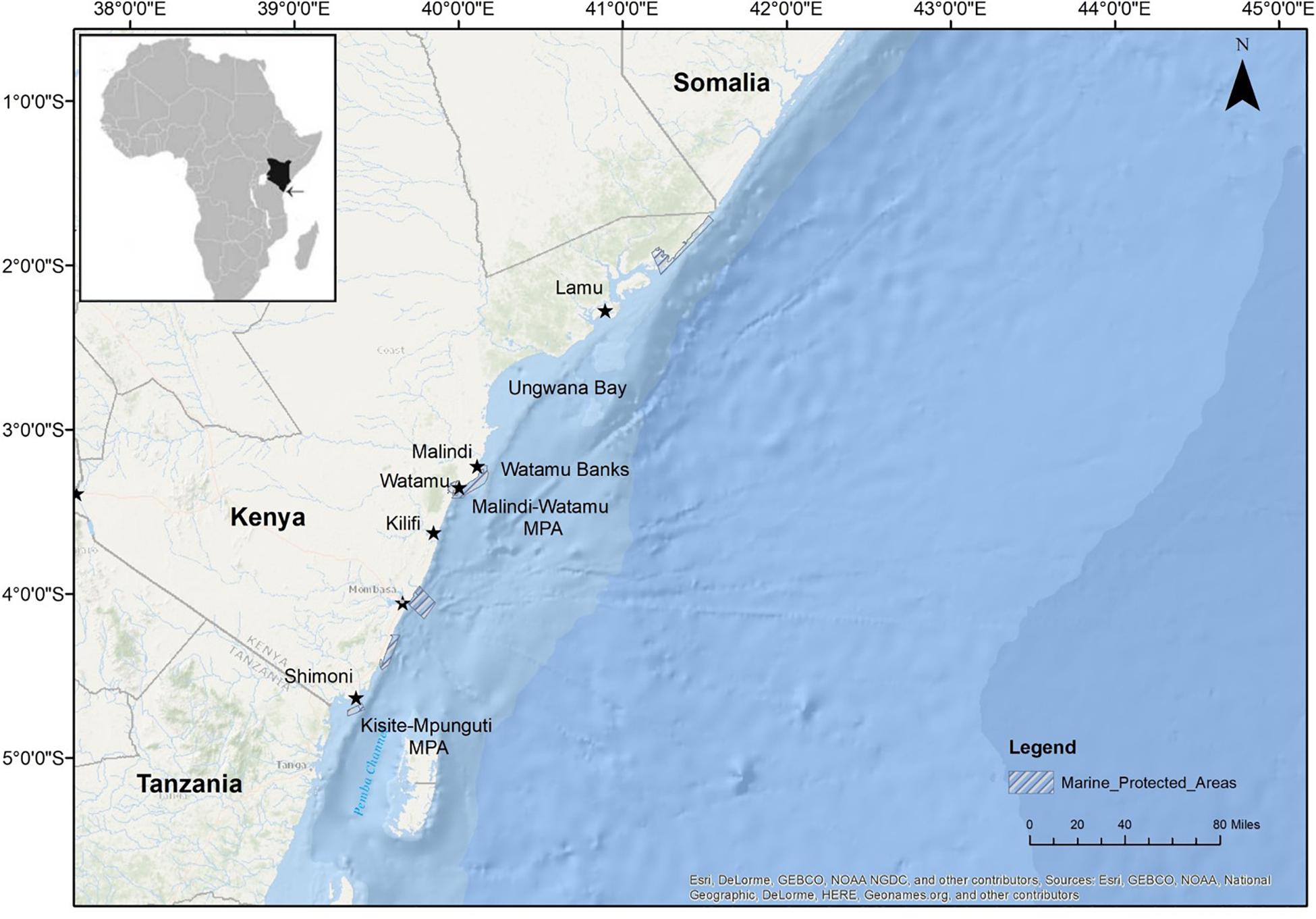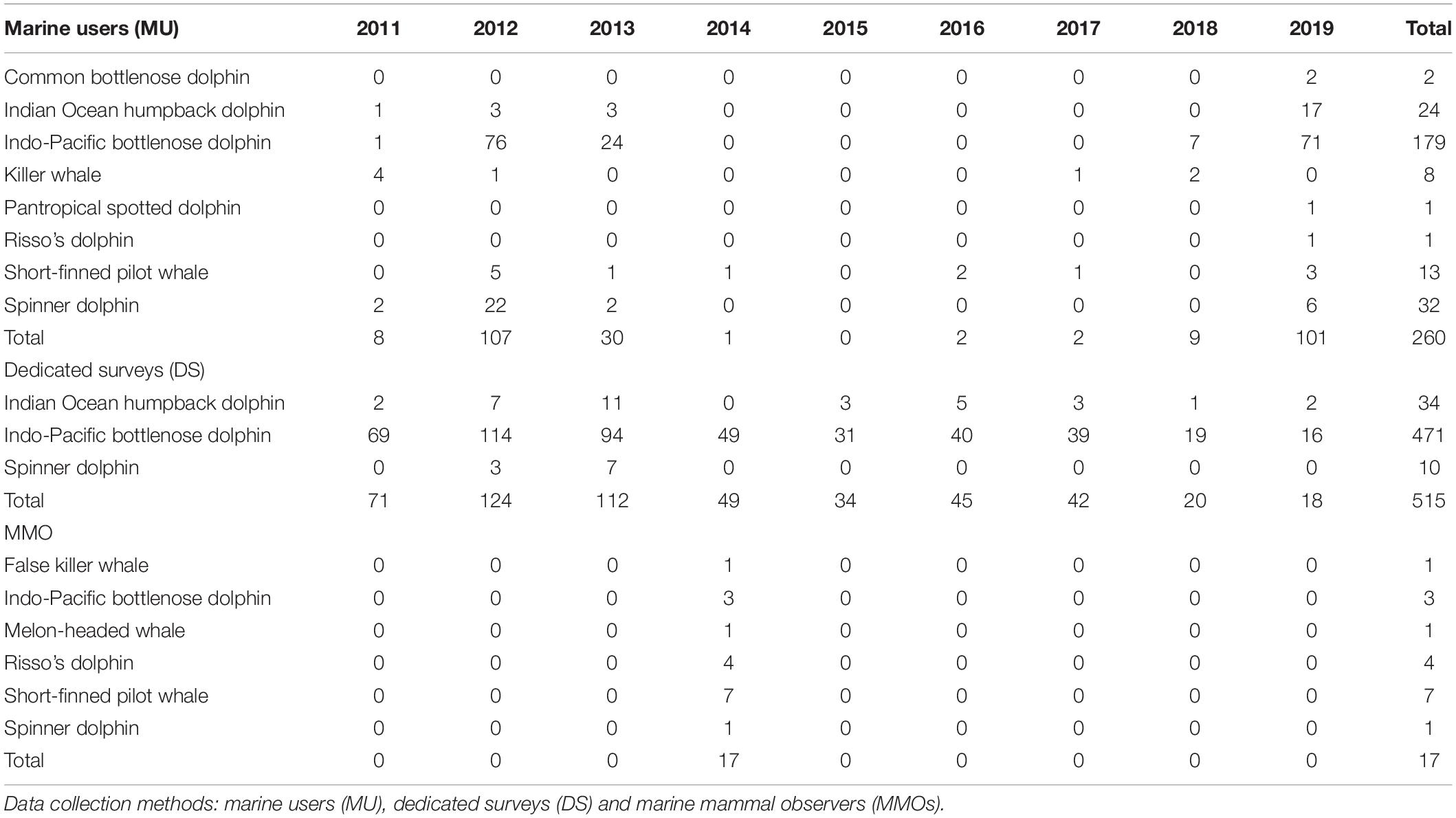Cetacean Research and Citizen Science in Kenya
- 1Watamu Marine Association, Watamu, Kenya
- 2Kenya Marine Mammal Network (KMMN), Watamu, Kenya
- 3Kenya Wildlife Service (KWS), Mombasa, Kenya
- 4Kenya Marine and Fisheries Research Institute (KMFRI), Mombasa, Kenya
- 5Global Conservation, Wildlife Conservation Society (WCS), Bronx, NY, United States
- 6Okeanos R&D Centre, Institute of Marine Research (IMAR), University of the Azores, Horta, Portugal
In 2011, several non-governmental and government agencies established the Kenya Marine Mammal Network (KMMN) to provide a platform for the consistent collection of data on marine mammals along the Kenyan coast, identify areas of importance and engage marine users and the general public in marine mammal conservation. Prior to the KMMN, relatively little was known about marine mammals in Kenya, limiting conservation strategies. The KMMN collects data nationwide through dedicated surveys, opportunistic sightings and participative citizen science, currently involving more than 100 contributors. This paper reviews data on sightings and strandings for small cetaceans in Kenya collated by the KMMN. From 2011 to 2019, 792 records of 11 species of small cetaceans were documented. The most frequently reported inshore species were the Indo-Pacific bottlenose dolphin and Indian Ocean humpback dolphin. Offshore species, included killer whales, short-finned pilot whale and long-snouted spinner dolphin. Indo-Pacific bottlenose dolphins, long-snouted spinner dolphins, striped dolphins and Risso’s dolphins were recorded through stranding reports. The efforts of the KMMN were disseminated through international meetings (International Whaling Commission, World Marine Mammal Conference), national status reports, outreach and social media. Data has also supported the identification of three IUCN Important Marine Mammal Areas and one Area of Interest in Kenya. Further research is needed to improve estimates of cetacean abundance and distribution, particularly in unstudied coastal areas, and to assess the extent of anthropogenic threats associated with fisheries, coastal and port development, seismic exercises and unregulated tourism. The expansion of the network should benefit from the participation of remote coastal fishing communities, government research agencies, tourism and seismic operations, among others. The KMMN demonstrated the value of dedicated and citizen science data to enhance marine mammal conservation strategies to boost awareness and eco-tourism and to bring the public and science closer together, promoting research and effective conservation efforts.
Introduction
The biodiversity and marine resources of Kenya and neighboring regions are critical for national economic development (Olson and Dinerstein, 1998). Protecting these resources has become increasingly urgent given the rapid expansion of regional development projects and associated anthropogenic threats. As part of a regional economic transformation, Western Indian Ocean (WIO) countries are accelerating plans to diversify their marine economies within the scope of the “Blue Economy” (Benkenstein, 2015; United Nations Economic Commission for Africa, 2015; Sacko, 2020). The main “pillars” of this strategy typically focus on three sectors; fisheries, maritime trade and the exploitation of natural resources (oil, gas, minerals). Whilst regional economic development is dependent on the success of these plans, they also represent major threats for many marine species, particularly cetaceans. Current work suggests that bycatch of small cetaceans in WIO fisheries already exceeds sustainable levels by a significant margin (Temple et al., 2018, 2019; Anderson et al., 2020). Shipping in the wider Indian Ocean has grown by 60% since 1992 (Tournadre, 2014), and the overall container demand in East and Southern African ports is predicted to increase with a compound annual growth rate of 3.76%, to a total of more than 600 million tons in 2050 (Humphreys et al., 2019). Development of the offshore oil and gas industry is also occurring at an increasingly rapid pace (e.g., Selley and Van der Spuy, 2016). However, there is a stark absence of primary data for cetaceans in this region. Recent research efforts, including the collection of citizen science data, have also been hampered by security issues on the Kenya and Somalia border.
Concerted efforts have been undertaken during the last two decades to improve the status assessment of marine mammal populations, both regionally and globally (Convention on Migratory Species [CMS], 2008; Burgener et al., 2012). However, a significant number of species remain classified as data deficient (International Union for Conservation of Nature [IUCN], 2020). The Western Indian Ocean (WIO) region has some of the highest marine biological diversity in the world, and represents an important cetacean hotspot (e.g., De Boer et al., 2002). Recent records include seasonal blue whales (Barber et al., 2016), Longmans beaked whales (Martin and Nimak-Wood, 2016), coastal bottlenose and humpback dolphins (Pérez-Jorge et al., 2015) and seasonally migratory humpback whales (Gilbert Mwang’ombe et al., 2015). However, the lack of a solid data baseline makes it difficult to plan effective conservation actions. There is no national marine mammal conservation strategy and for many of the species known to occur off Kenya there are significant knowledge gaps on population abundance, distribution, habitat use, genetic diversity and population structure.
There is limited information available on the interaction of marine mammal populations with small-scale fisheries of the SWIO (Kiszka et al., 2009). Where data exist, there is evidence of both targeted and incidental catch (Temple et al., 2018), with physical evidences of injuries from fisheries interactions (Kiszka et al., 2008; Morley et al., 2010), in some instances as high as 41% of Indian Ocean humpback dolphins in a single Tanzanian study (Gill Braulik pers comm). The extensive use of coastal gillnets and the existence of several reports on accidentally caught inshore species, such as Indo-Pacific bottlenose and Indian Ocean humpback dolphins, discloses a high potential for bycatch in the region (Kiszka et al., 2009; Kiszka, 2012; Kenya Marine and Fisheries Research Institute unpublished data). For the populations of Indian Ocean humpback dolphin, gillnet bycatch is even considered the primary threat (Braulik et al., 2015).
The rise in popularity of dolphin watching off Kenya and neighboring Tanzania is considered a contributing factor for displacing dolphins from favored habitats, and changes in behavior (Stensland et al., 2006), pose a potential threat to populations if not regulated (Wamukoya et al., 1996; Pérez-Jorge et al., 2016, 2017). Local communities have operated dolphin-watching excursions in two Kenyan Marine Protected Areas (MPAs) since the mid 1990’s (Kisite-Mpunguti MPA (KMMPA) and Malindi-Watamu MPA (MWMPA). However, public awareness of cetaceans is poor, particularly when compared to Kenya’s more famous terrestrial wildlife and protected areas. Given that studying cetacean populations, especially in isolated areas, can be costly, time consuming and logistically difficult, this is perhaps not so surprising. Hence, little is known about the effect of increasing human related threats to marine mammals within national waters (Wamukoya et al., 1996).
In 2011, the Kenya Marine Mammal Network (KMMN) was formed by governmental and non-governmental organizations with the objectives of improving marine mammal data collection and availability in Kenyan waters and to increase national awareness and protection efforts. Data is gathered during both dedicated scientific surveys as well as opportunistic sightings collected by a diverse network of “citizen scientists” that routinely use Kenyan coastal and offshore ecosystems. Comparatively high cost surveys are limited to inshore studies, whereas the KMMN platform encourages low cost citizen science reports from remoter inshore and offshore locations. Opportunistic sightings largely depend on the fishing, touristic and recreational operators, as well as offshore oil and gas operations, significantly enhancing the previously limited database.
This paper reviews KMMN data that combines reports of marine users, dedicated small cetacean research efforts, and stranding data between 2011 and 2019. It also highlights the value of this data to (1) improve current awareness of small cetaceans in Kenyan waters; (2) advance regional species status assessment; and (3) improve conservation efforts associated with the development of the Blue Economy.
Materials and Methods
Area of Interest
Data assessed in this paper were all collected in Kenyan waters. The Kenyan coastline is ∼650 km long, and lies between Somalia in the north (Ishakani, 1.7°S; 41.5°E) and Tanzania in the south (Vanga, 4.7°S; 39.2°E) (Kenya Marine and Fisheries Research Institute [KMFRI], 2018; Figure 1). The coastal region is generally characterized by an extensive fringing reef, and is otherwise endowed with biologically rich coastal and marine ecosystems. Kenya experiences two distinct seasonal monsoons, with the Northeast Monsoon (NEM) from November to March and the South East Monsoon (SEM) from April to October. The former is the drier period with calmer sea conditions, and the latter is characterized by the “long rains” and rougher seas and difficult navigating conditions.
Data Sources
Most of the data was reported by marine users related to tourism activities, including fishing, diving and marine excursions. These activities are seasonal and largely dependent on tourism intensity and the monsoon weather conditions. Occasional marine mammal offshore information was provided by Marine Mammal Observers (MMO’s). Dedicated surveys focused on two marine protected areas: KMMPA and MWMPA, located on the south and north coast, respectively (see Figures 1, 6–8), managed by Kenya Wildlife Service (KWS).
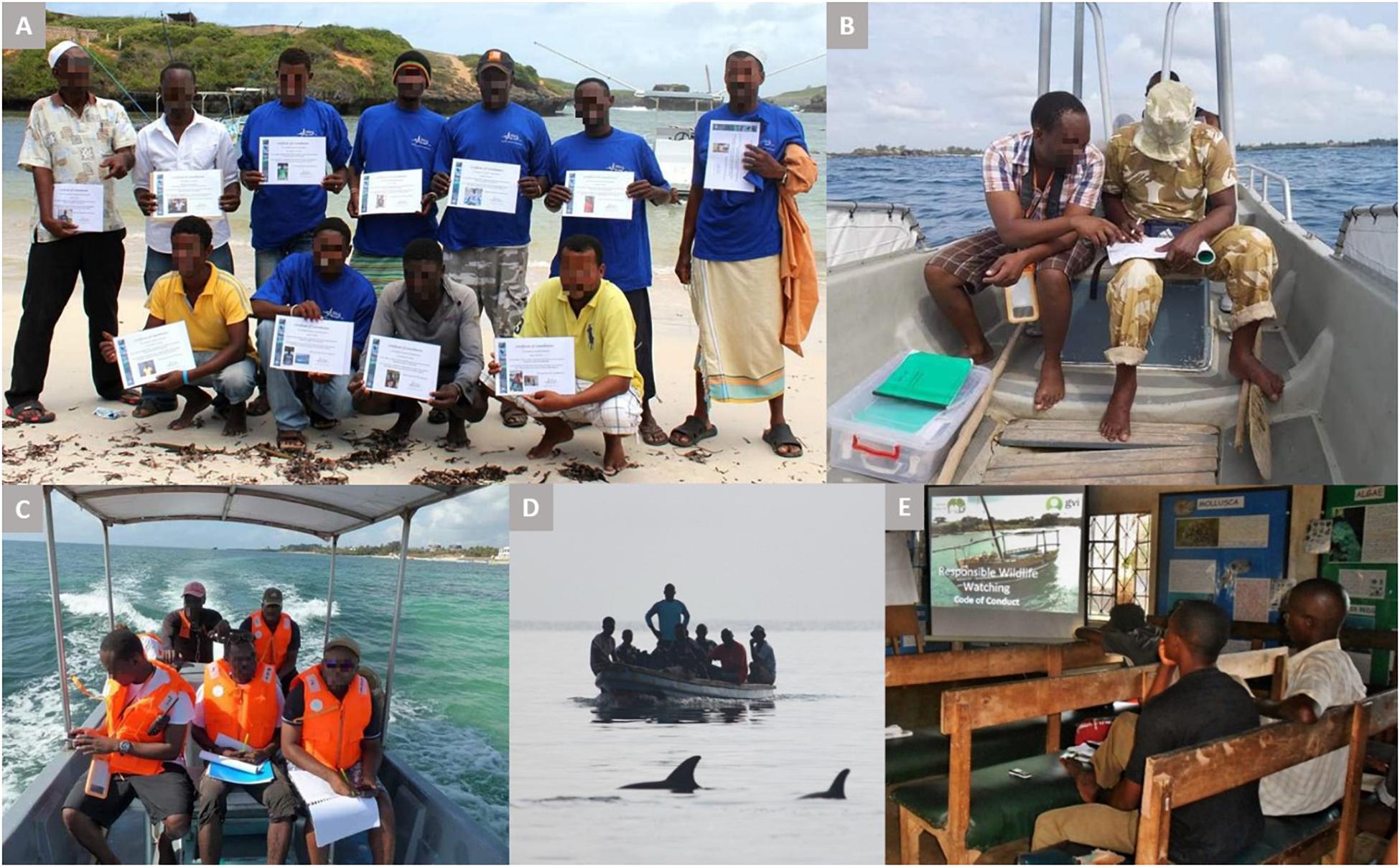
Figure 2. Marine users. (A) Fishermen and tour operators from Watamu receive certificates from WMA after completing a training in marine mammal identification and sustainable whale watching practices (2013). (B,C) WMA training KWS in marine mammal boat based surveys in Malindi Marine Park (2018, 2019). (D) Indo-Pacific bottlenose dolphin sighting reported by South Coast MUs (2012). (E) Workshop on species identification and eco-tourism for tour operators in the Kisite-Mpunguti Marine Protected Area (2012).
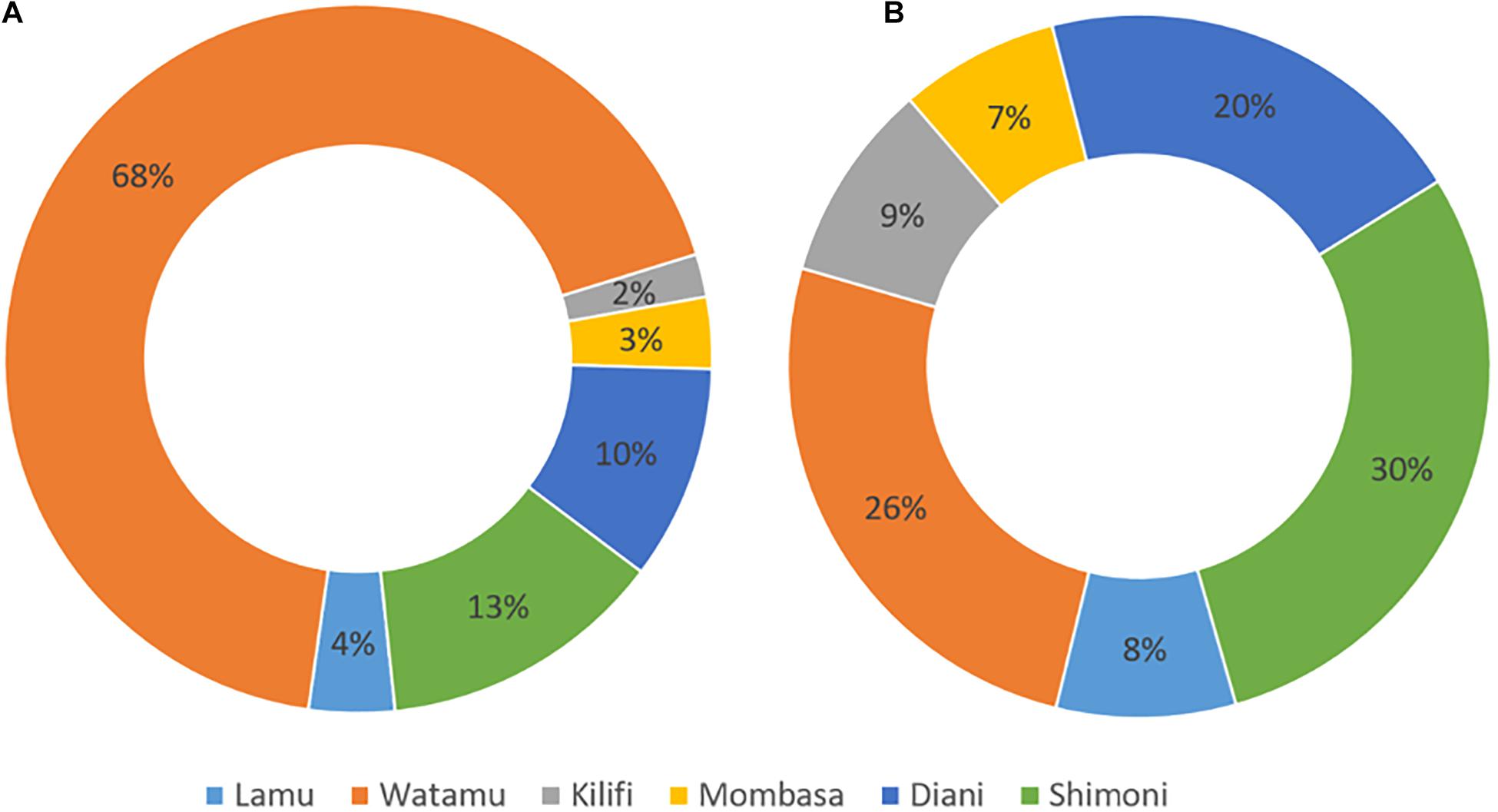
Figure 3. Geographical coverage of the KMMN MU reports: (A) from 2011 to 2017, (B) from 2018 to 2019.
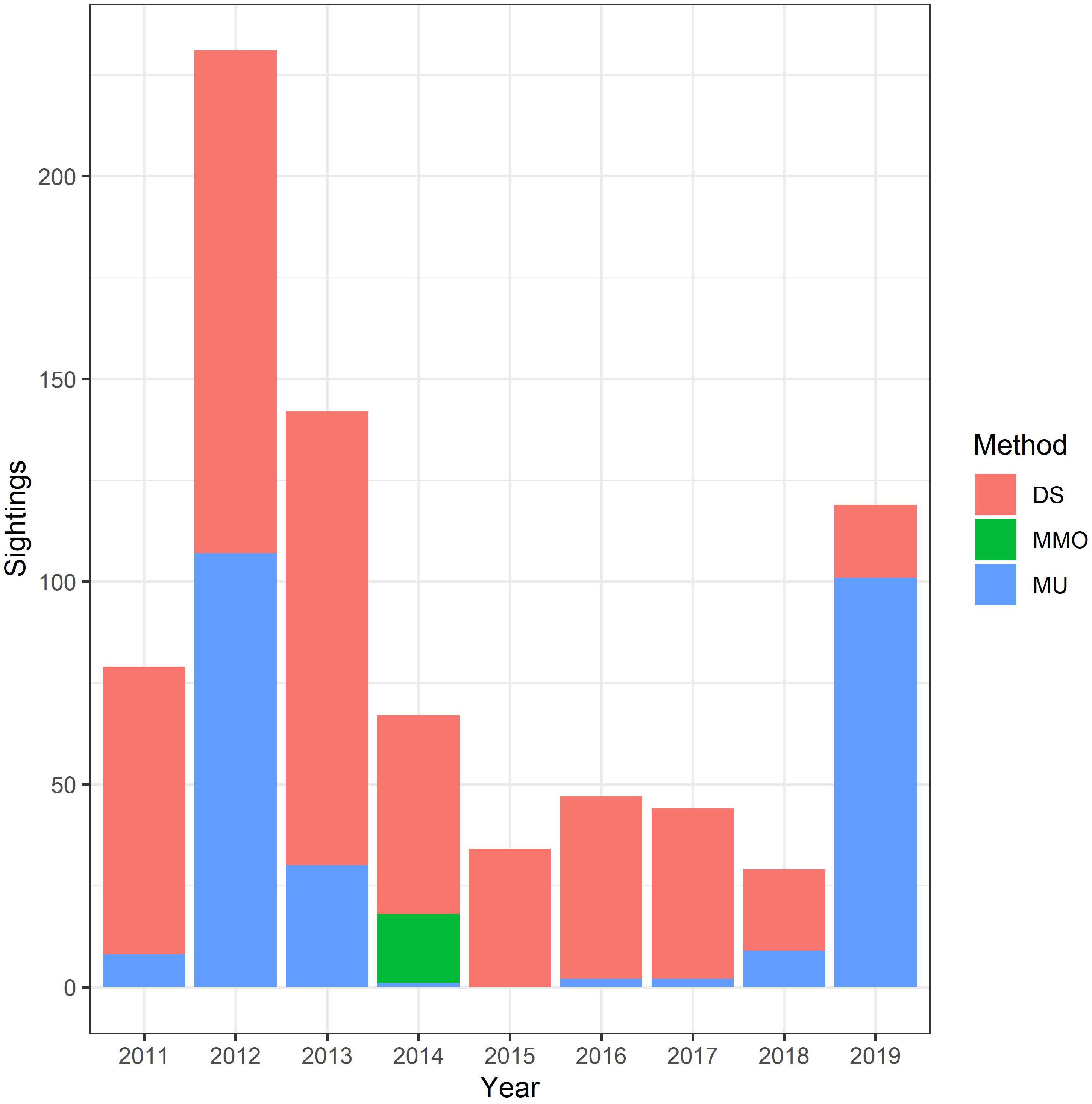
Figure 4. Number of reports per data collection method and year between 2011 and 2019. Data collection methods: marine users (MU), dedicated surveys (DS) and marine mammal observers (MMOs).
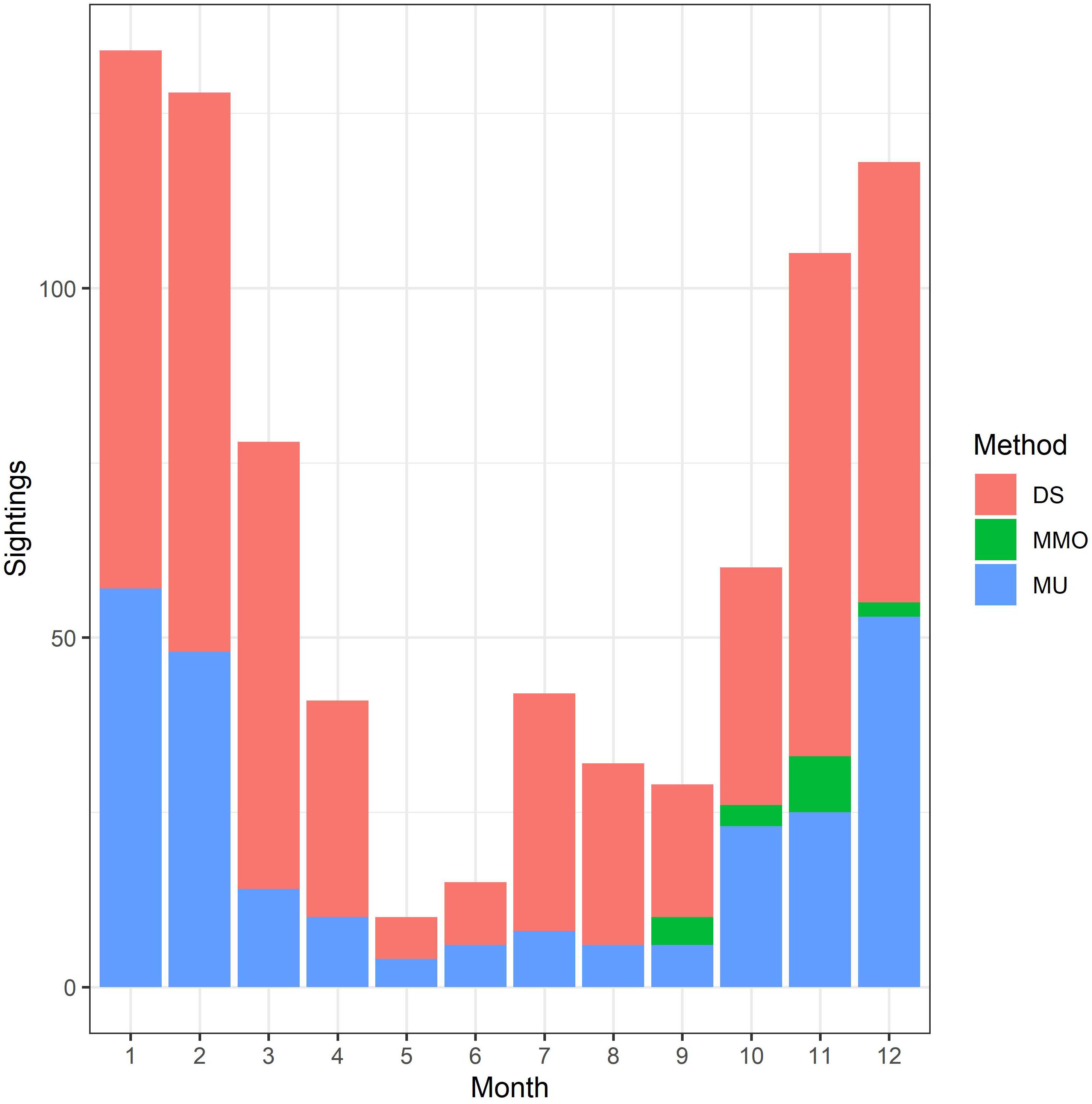
Figure 5. Number of reports per data collection method and month from 2011 to 2019. Data collection methods: marine users (MU), dedicated surveys (DS) and marine mammal observers (MMOs).
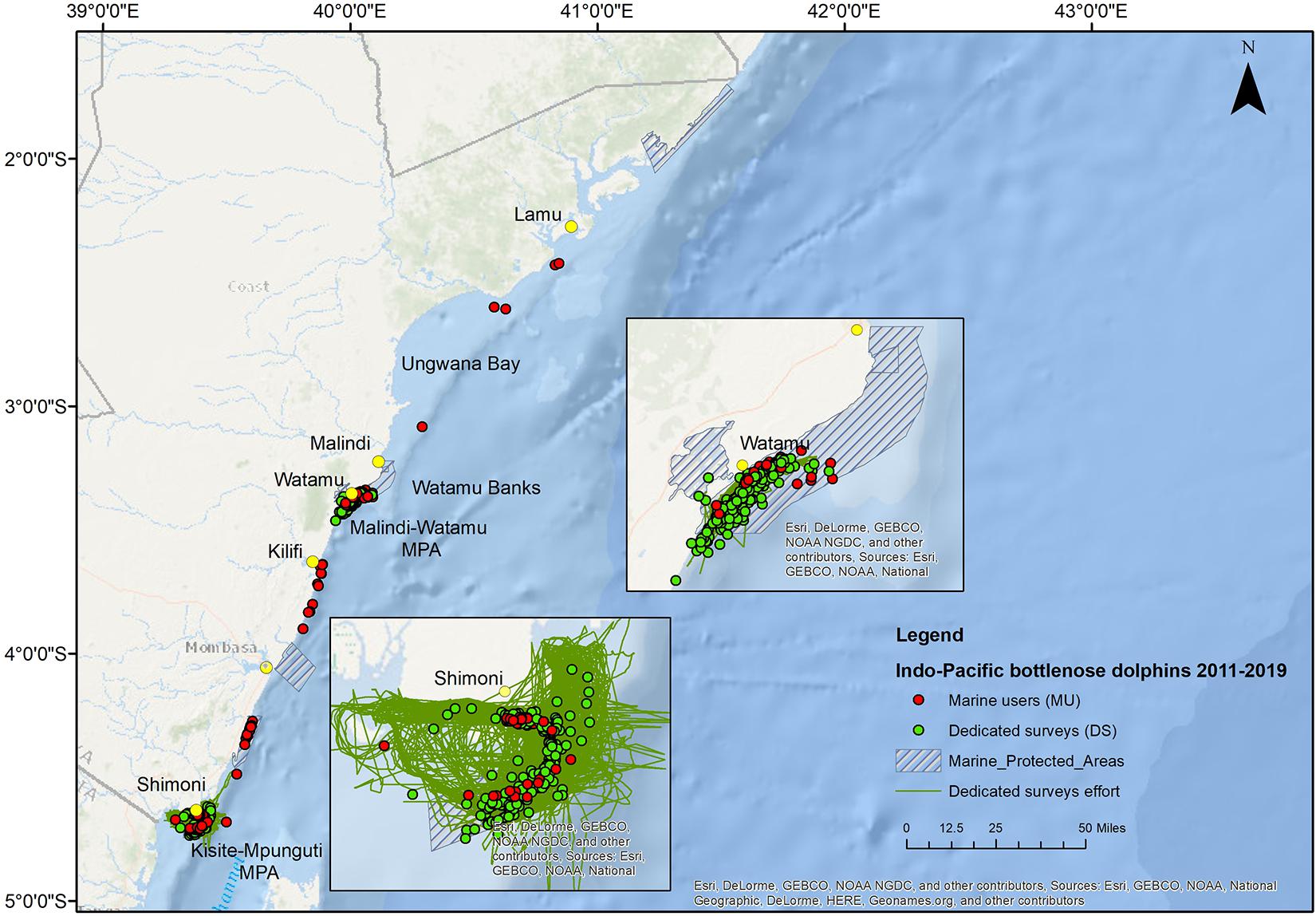
Figure 6. Map showing the distribution of Indo-Pacific bottlenose dolphin sightings between 2011 and 2019 along the Kenyan coast. The boxes in the map show the areas with the highest number of reports, Kisite-Mpunguti Marine Protected Area (southern Kenya) and Malindi-Watamu Marine Protected Area (central Kenya).
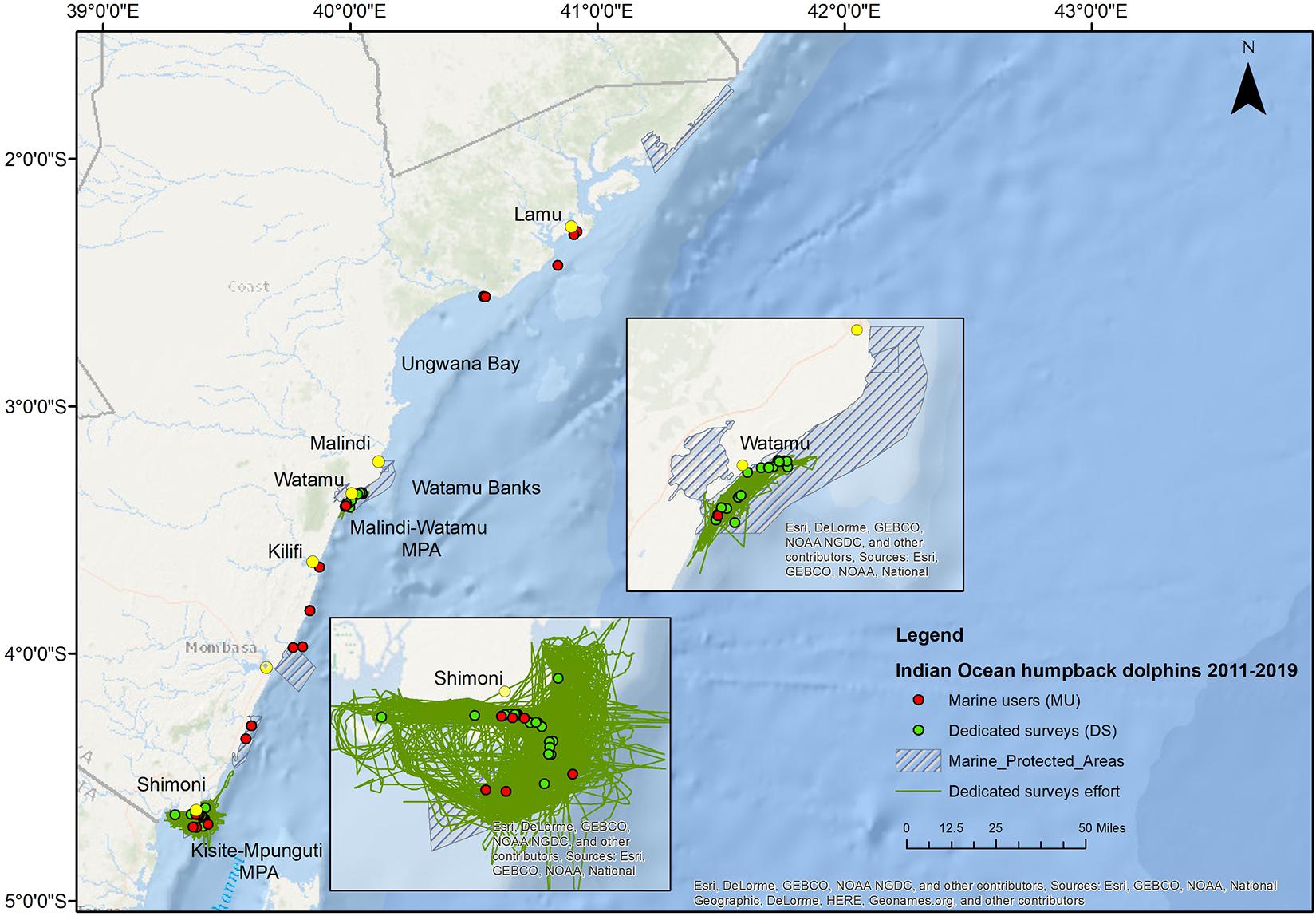
Figure 7. Map showing the distribution of Indian-Ocean humpback dolphin sightings between 2011 and 2019 along the Kenyan coast. The boxes in the map show the areas with the highest number of reports, Kisite-Mpunguti Marine Protected Area (southern Kenya) and Malindi-Watamu Marine Protected Area (central Kenya).
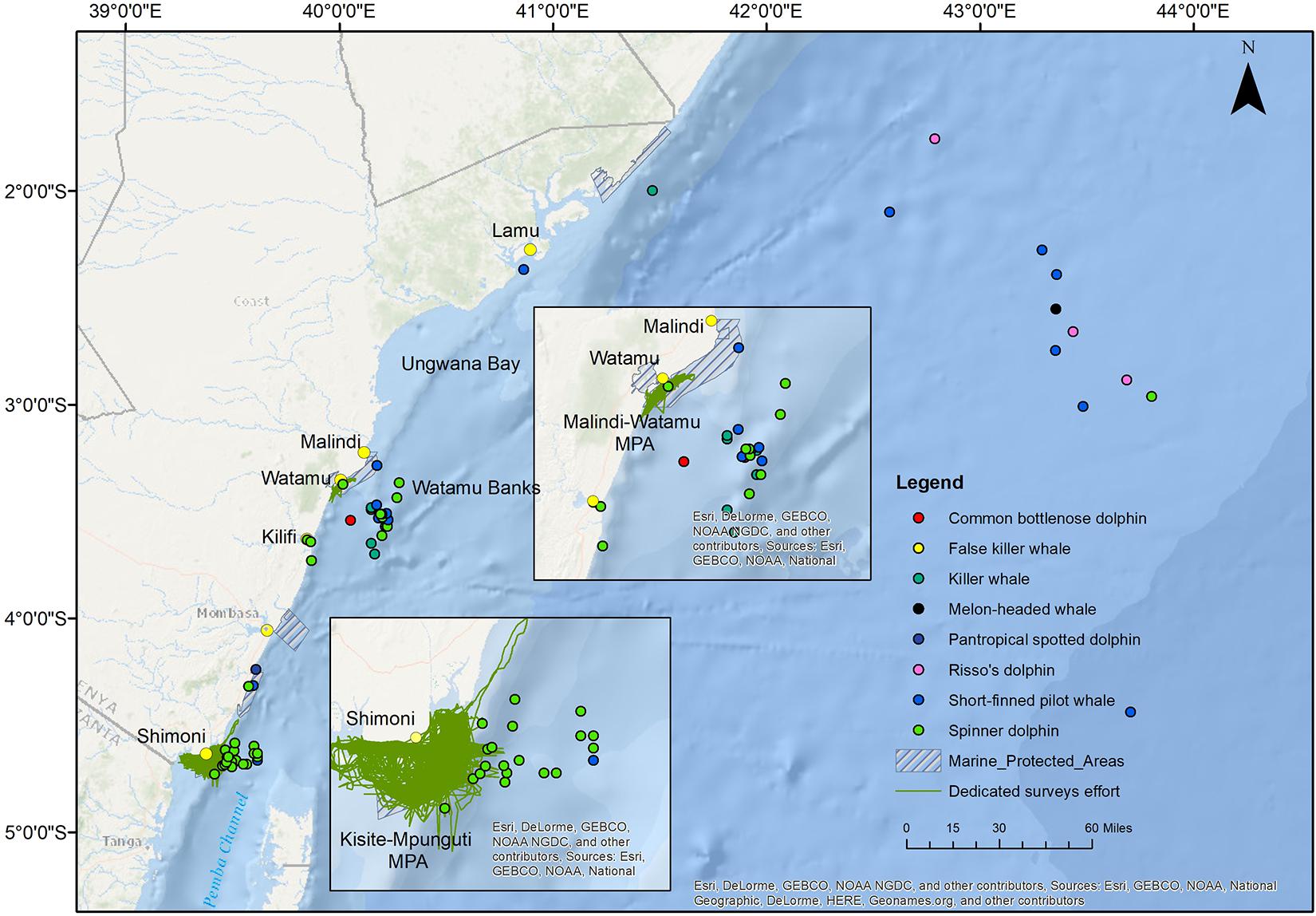
Figure 8. Map showing the distribution of sightings of other small cetacean species sightings along the Kenyan coast. The boxes in the map show the areas with the highest number of reports, waters surrounding Kisite-Mpunguti Marine Protected Area (southern Kenya) and Malindi-Watamu Marine Protected Area (central Kenya).
Marine Users (MU)
Opportunistic sightings by MU were reported from offshore and coastal areas. The majority of MU effort occurs in and around the KMMPA, Diani and MWMPA and is associated with inshore tourism activities, including marine safaris, snorkeling, standup paddle and diving. These tourism activities are generally dependent on calm seas, with most activities taking place within 2 km from shore throughout the year, mainly within the MPAs. Most coastal operators participated in training workshops on marine mammal ecology, species identification and sustainable ecotourism practices organized by members of the KMMN (KMMN, 2012, 2013a, 2013b, 2013c). Additional workshops were organized regarding marine mammal boat surveys and a whale disentanglement response training (KMMN, 2020; Figure 2). These trainings, together with the fishermen and tour operator’s local ecological knowledge, greatly improved the quality of the data on eyewitness reports of inshore species. Offshore waters are mainly covered by deep sea fishermen, including Watamu Banks, Pemba Channel and the Lamu Archipelago. Sightings of offshore marine mammals from deep sea fishermen were commonly confirmed by pictures and videos, which facilitated cross-checking of species identification. Marine mammal sightings were reported to the KMMN including information on the species, Global Position System (GPS) positions, number of animals and any other relevant information, such as behavior or other species present. Videos and photographs were also requested to confirm species identification and to add high quality photographs of dorsal fins and flukes to regional catalogs. All sightings were recorded in an excel database, and were reported to the KMMN data center at the Watamu Marine Association (WMA) office in Watamu via mobile phone calls, e-mail, social media or, from 2017 on, through the KMMN WhatsApp group.
Dedicated Surveys (DS)
Data from localized inshore research studies focused on the two sites: KMMPA from 2011 to 2013 (a total of 168 surveys) and MWMPA from 2011 to 2019 (a total of 182 surveys) (Gilbert Mwang’ombe et al., 2015; Pérez-Jorge et al., 2015, 2016; Figures 6–8). Dedicated boat-based surveys were seasonal and conducted during the NEM in the MWMPA and occurred year round in KMMPA. A four-member research team, scanned the water surface over 180° field of vision from the beam to the bow the boat. Each observer covered a 45° subsection of the field of vision. Team members rotated every 15 min during the survey. Non-systematic transects were carried out during the surveys, covering a total area of approximately 70 and 250 km2 in MWMPA and in KMMPA, respectively (Figures 6–8). The research team observed the animals to identify species, composition, behavior and reaction to other boats (especially dolphin watching tour boats). In addition, photo-id and behavioral data was collected based on the protocols developed in the surveys around the KMMPA (Pérez-Jorge et al., 2015, 2016).
Seismic Survey Marine Mammal Observer (MMO) Reports
Occasional reports were received by the KMMN from Marine Mammal Observers (MMOs) working onboard oil and gas seismic survey vessels in Kenya offshore waters. Data was collected between September and December 2014 from a survey area of 6000 km2 located at 120 nautical miles north of Lamu (Barber et al., 2016). During these surveys, dedicated watches were conducted from the vessel at a height of 22 m, using the naked eye and binoculars (8× magnification). Survey effort was recorded, as well as marine mammal sightings (species, location and behavior), water depth and environmental conditions. Photographs were obtained using an SLR camera with a 100–300 mm zoom lens for identification purposes. The MMO data presented here represent a subset of all the MMO data collected in Kenyan waters, but these were not available for this study.
Strandings
Strandings were reported through the KMMN WhatsApp group or by phone call. A team was deployed to the site comprising of KWS and WMA members. Whenever possible, necropsy procedures, photographs, measurements and samples were collected for further analysis following standardized protocols (with the assistance from members of the International Whaling Commission Strandings’ Expert Panel). Here, we only report the species and strandings location. Data are stored into the KMMN database, which was plotted in GIS to produce the maps depicting distribution of species, using WGS84 Datum, with Arc Map 10.6 (Geographic information system company [ESRI], 2011). The base map of Kenya was obtained from ESRI Base maps.
Results
Sightings
Between 2011 and 2019, 10 species of small cetacean were reported from inshore and offshore Kenyan waters, accounting for a total of 792 sightings (Table 1): spinner dolphins (Stenella longirostris), Pantropical spotted dolphins (Stenella attenuata), Risso’s dolphins (Grampus griseus), Indian Ocean humpback dolphins (Sousa plumbea), common bottlenose dolphins (Tursiops truncatus), Indo-Pacific bottlenose dolphins (Tursiops aduncus), short-finned pilot whales (Globicephala macrorhynchus), false killer whales (Pseudorca crassidens), killer whales (Orcinus orca) and melon-headed whales (Peponocephala electra).
The number of regular MU contributors reporting marine mammal sightings to the network increased, from around 10 contributors in 2017, up to more than 25 reporters in 2018–2019, covering the north, central and southern coastal region. This increase is related to the more routine use of smartphone technology as a communication tool. The KMMN WhatsApp group was implemented in 2017, and in 2020 comprised over 100 members from Kenya and neighboring countries, including marine users, managers, and also marine mammal scientists from the Western Indian Ocean and overseas. Prior to the setup of the KMMN WhatsApp group (2011–2017) the MU sightings covered primarily the main coastal touristic areas in Kenya (Watamu, Diani and Shimoni), which encompassed 91% of all reports. In 2018–2019, the growing number of KMMN contributors allowed the expansion of the network geographical range, resulting in about 25% of sightings coming from Lamu, Kilifi and Mombasa, which is particularly important since these areas were not covered by dedicated surveys (Figure 3). The KMMN WhatsApp group also brought an important increased on the percentage of reported sightings that included photos or videos, from only 6% in the period 2011–2017 to 46% in 2018–2019. Submitted sightings with incomplete information (e.g., location or species) or reported by unexperienced MU without including photos/videos to validate them were not included in the database, representing less than 5% of the total.
Dedicated surveys (DS) reported the largest number of sightings (n = 515), followed by marine users (MU) with 260 sightings and finally 17 reports from MMOs (Table 1). The Indo-Pacific bottlenose dolphin, Indian Ocean humpback dolphin and spinner dolphin were most frequently encountered by MU and DS. The most abundant species reported by MMOs was the short-finned pilot whale. MU’s, specifically sports fishers, regularly encounter short-finned pilot whales and less frequently reported killer whales, common bottlenose dolphins, Pantropical spotted dolphin and Risso’s dolphin.
Regarding MU, 2012 was the year with the most sighting reports (107), following the establishment of the KMMN. Very few MU sightings were recorded in 2014–2017 (5), a period of political instability and drop in tourism. MU reports increased again in 2018 and most significantly in 2019 (101 sightings, Figure 4 and Table 1). In 2019, 17 MU sightings of the critically Endangered Indian Ocean humpback dolphins exceeded all 14 DS reports between 2015 and 2019. This increase in MU reports followed the set up and dissemination of the KMMN WhatsApp group. This platform allowed for the growth of the network participants, an increase in sightings reports and diversity, as well as the expansion of the network’s geographical range (see Figure 3).
Most of the DS reports occurred in the period between 2011 and 2013, with the efforts concentrated in KMMPA and MWMPA. From 2015 to 2019 surveys were limited to the MWMPA and decreased significantly in 2018 and 2019 due to financial limitations. MMO’s recorded a total of 15 sightings in the Kenyan EEZ over a duration of 127 days. These sightings identified six small cetacean species, in a very short period, compared with less experienced MUs, who take longer to provide positive species identification, and reported 8 species over 9 years.
Both reports from MU and DS showed an increase between the months of October to March, during the NEM period, which corresponded to an increase in tourism activities and DS due to good weather conditions, contrasting with the SEM (April to August) (Figure 5).
The most frequently reported species, the Indo-Pacific bottlenose and the Indian Ocean humpback dolphin, were sighted in inshore waters (Figures 6, 7). The number of reports greatly depend on the number and location of MU collaborators and DS opportunities. The largest number of reports are from within the KMMPA and MWMPA, given the high numbers of tourism operators, marine wildlife rangers, recreational users and DS research projects. Inshore species were also reported in Kilifi and Lamu (Figures 6, 7). Spinner dolphins, common bottlenose dolphins, killer whales, pantropical spotted dolphins and short-finned pilot whales were reported within 17 nm of the coast, in offshore waters (Figure 8). False killer whales, Risso’s dolphins and melon-headed whales were sighted near the limits of the Kenyan EEZ by the MMOs (Figure 8).
In order to relate MU and DS data collection methods, the mean and median group size were compared between MU and DS for Indo-Pacific bottlenose dolphin and Indian Ocean humpback dolphin (Table 2). For the Indo-Pacific bottlenose dolphin, the mean and median group size was very close between the two methodologies, with DS reporting slightly higher values, including the maximum group size reported. For the Indian Ocean humpback dolphin, the mean group size was the same for MU and DS and slightly higher median group size for the DS. For spinner dolphins, MU reported a much larger mean group size compared to DS.
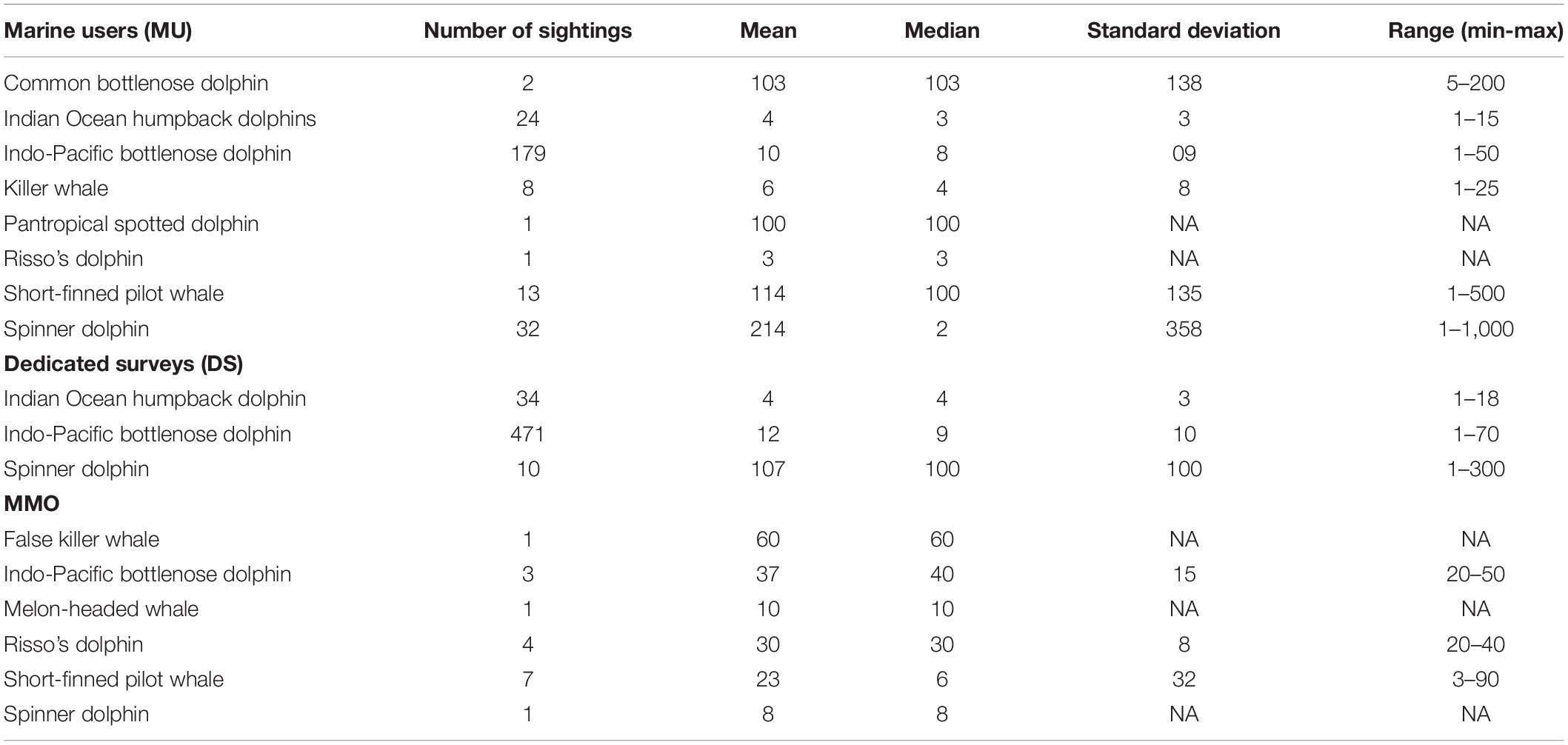
Table 2. Number of sightings, mean and median group size, standard deviation and range per species and data collection method.
Stranding Records
A total of 14 reports of dead small cetaceans were recorded along the Kenyan coast between 2011 and 2019 (Figure 9), including Indo Pacific bottlenose dolphin (3), spinner dolphin (4), melon-headed whale (2), striped dolphin (2), Risso’s dolphin (1) and unknown dolphin (2) The reports partially reflect the areas where there is high human population density and tourism with eight strandings reported in central Kenya and five within the MWMPA. A necropsy was conducted on a single Indo-Pacific bottlenose dolphin, and tissue samples were preserved for analysis.
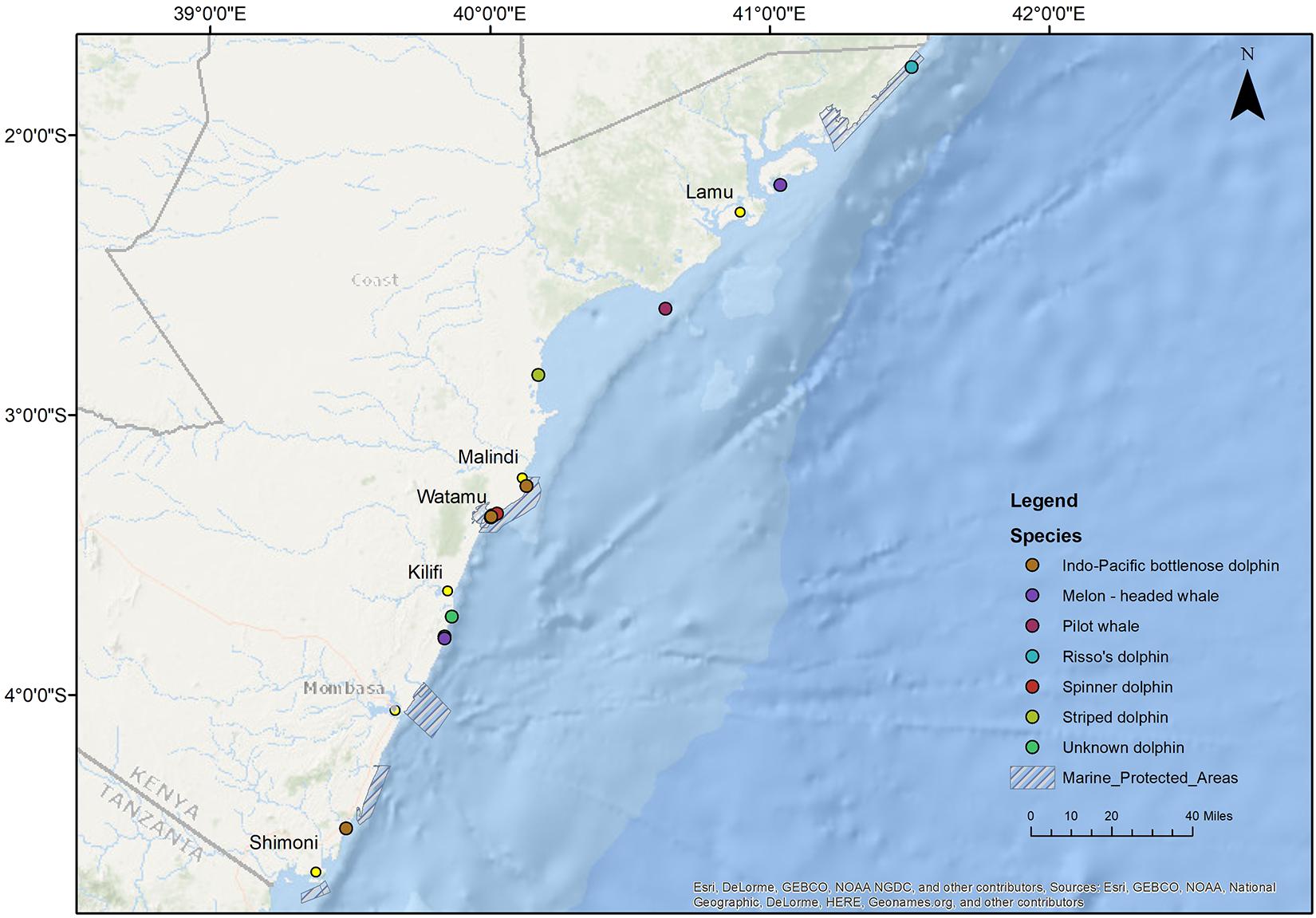
Figure 9. Locations of stranded small cetaceans reported along the Kenyan coast between 2011 and 2019.
Discussion
Small Cetacean Diversity in Kenya Compared With the SWIO
A total of 16 species of delphinids have been recorded in the SWIO, of which 10 were described to occur in Kenya by Kiszka et al. (2009). The KMMN has recorded 11 species to date, through sightings and stranding’s data, including the first reports of three species (T. truncatus, G. macrorhynchus, and P. crassidens), demonstrating a high diversity of small cetaceans in Kenyan waters, and the value of the KMMN data collection platform. Common dolphins (Delphinus spp.) and Fraser’s dolphins (Lagenodelphis hosei), previously sighted in Kenya, were not sighted or reported stranded by the KMMN (Kiszka et al., 2009). The most frequently sighted species reported to the KMMN are Indo-Pacific bottlenose and Indian Ocean humpback dolphins. Dedicated research surveys in the KMMPA and MWMPA using photo identification techniques suggested site-fidelity for Indo- Pacific bottlenose and Indian Ocean humpback dolphins (Meyler et al., 2012; Pérez-Jorge et al., 2015) consistent with results from previous studies off East Africa, including Maputo Bay in Mozambique (Guissamulo and Cockcroft, 2004), Algoa Bay in South Africa (Melly et al., 2017; Bouveroux T. et al., 2018; Bouveroux T. N. et al., 2018) and off southern Zanzibar (Amir et al., 2002, 2005; Stensland et al., 2006; Stensland and Berggren, 2007).
The Endangered Indian Ocean humpback dolphin have been reported within the WIO, in Kenya (Wamukoya et al., 1996), Tanzania (Stensland et al., 2006; Braulik et al., 2017, 2018), Mayotte (Kiszka et al., 2007), Madagascar (Cockroft and Young, 1998; Cerchio et al., 2015), Mozambique (Guissamulo and Cockcroft, 2004) and East coast of South Africa (Koper et al., 2016; Bouveroux T. et al., 2018). In Kenya, a total of 104 (95% CI 67–160) Indian Ocean humpback dolphins were estimated to inhabit the KMMPA and Shimoni Archipelago (Meyler et al., 2012). This estimate was analogous to that recorded in similar habitat off the south coast of Zanzibar and northern Tanzania (63, 95% CI 57–95, Stensland et al., 2006). The potential for interchange of animals from these geographic areas (less than 200 km apart) requires assessment, but currently there is no evidence of movement between Zanzibar or northern Tanzania and Kenya. However, four photo-identified dolphins were sighted at two different locations 170 km apart in Kenya, indicating capacity for significant movement.
Indo-Pacific bottlenose dolphins have been recorded around Kenya (Gilbert Mwang’ombe et al., 2015; Pérez-Jorge et al., 2015), Tanzania (Braulik et al., 2018), off the Seychelles (Marine Conservation Society Seychelles, unpublished data), Mayotte (Kiszka et al., 2007), the Union of the Comoros (Kiszka et al., 2006), Madagascar (Cerchio et al., 2015), Mauritius (Mauritius Marine Conservation Society, pers. comm.), Réunion (Dulau-Drouot et al., 2008), Mozambique Bay (Guissamulo, 2008) and South Africa (Caputo et al., 2021). In southern Kenya, a small population size was estimated with a mean of 65 dolphins (SE: 7.06), with seasonal fluctuations ranging from 20 (95% CI 11–36) to a maximum of 102 individuals 95% CI 77–138) (Pérez-Jorge et al., 2016). In neighboring Zanzibar, the population size of the Indo-Pacific bottlenose dolphin was estimated at 136 individuals (95% CI 136–179; Stensland et al., 2006). Regarding these two inshore delphinids species, the KMMN has proved to be an efficient data collection platform for species occurrence, providing annual data and promoting national awareness, through complementary methods of data collection and dissemination. This is particularly important, as it has been considered that populations with less than 100 individuals have a higher extinction risk (Thompson et al., 2000). Additionally, small populations, such as the Indo-Pacific bottlenose dolphin, and Indian Ocean humpback dolphin might be particularly vulnerable to human disturbances due to their high site fidelity and coastal distribution.
Reports of offshore pelagic species within the KMMN dataset are consistent with records from other oceanic waters from the SWIO. The pantropical spotted dolphin (S. attenuata) and the spinner dolphin (S. longirostris) were the most common delphinid species reported in Kenyan oceanic waters (Balance and Pitman, 1998). Spinner and pantropical spotted dolphins have been recorded in deeper oceanic waters throughout the SWIO (Kiszka et al., 2015).
Records of Risso’s dolphin in Kenya prior to 2018 were limited to dead individuals; the first live sighting was reported to the KMMN in 2019. SWIO sightings include southwest coast of Madagascar (Cerchio et al., 2015), the Seychelles (Kruse et al., 1991), South Africa (Best, 2007; Plön et al., 2020b), Mozambique, Mayotte, the Union of the Comoros (Kiszka et al., 2006) and Zanzibar (Amir et al., 2002). Other species commonly referred to as “Blackfish” have also been reported in the southwest Indian Ocean (Kiszka et al., 2009) with reports of Killer whales and Melon-headed whales off Kenya (Wamukoya et al., 1996). Here, MU reported sightings between 15 and 40 km off shore of killer whales (O. orca), short–finned pilot whales (G. macrorhynchus), and false killer whale (P. crassidens), the latter was also observed by DS inshore of the MWMPA (Gilbert Mwang’ombe et al., 2020).
Live and dead strandings are important to identify species which are found off shore and are rarely seen. Strandings can provide valuable information about anthropogenic pressures and impacts experienced by small cetaceans in deeper oceanic waters within Kenya. Risso’s dolphin (Grampus griseus), melon-headed whale (Peponocephala electra) and striped dolphin (Stenella coeruleoalba have also been recorded.
Comparison of Methodologies
Reported sightings by MU varied between the years and greatly depended on tourist activity in coastal Kenya, especially around marine protected areas. In 2012, there was a peak in overall MU reports, following a concerted effort by boat operators in the MWMPA. The decrease in MU reports from 2013 to 2018 was determined in part by a downturn in tourism in Kenya linked to security concerns (Buigut, 2018). The sharp increase in MU reports in 2019 corresponds to a rise of KMMN collaborators along the coast, increased marine mammal national awareness campaigns, smart phone use and dissemination of user friendly apps for reporting. The growing number of smart phones with cameras and GPS capability marked an important step in the number and quality of the MU reports. The decrease in DS reports from 2013 was the result of the cancelation of research projects in the KMMPA, as the main organization (Global Vision International1) leading the surveys left the country due to security concerns (Buigut, 2018). From 2014 to 2019, DS sightings were limited to the MWMPA, and showed a gradual decrease in effort, given limited research funds.
Overall, MU sightings covered a greater area, occurred year-round, and reported a larger diversity of species than DS, which were more dependent on financial resources and weather conditions. On the other hand, DS provided reliable photo identification and behavioral data (Pérez-Jorge et al., 2015, 2017), in comparison to MU data which was limited to information on species, location and size of group. Important records have also been provided by MMOs onboard seismic survey vessels, identifying rarely reported species in Kenya, such as the melon-headed whale. In addition, MMOs were especially valuable in the north Kenya waters, since there was a data gap for the Lamu, Kiunga, and the Kenya-Somalia.
Conservation Issues
A diverse suite of anthropogenic threats to marine mammals has been described by several authors worldwide (Reeves et al., 2013; Avila et al., 2018). Several of these are known to occur in the WIO, although necessary work to measure their extent and importance for cetaceans remains limited. They include bycatch (e.g., Kiszka et al., 2009; Temple et al., 2019), offshore oil and gas development, port expansion (Muthike, 2018) and a concomitant increase in shipping traffic, underwater noise and pollution from a variety of sources, particularly riverine flows of effluent, agricultural chemicals and plastics (Koper and Plön, 2012; Celliers and Jackson, 2016; Okuku et al., 2020). In Kenya there is some evidence of Indo-Pacific bottlenose and Indian Ocean humpback dolphin bycatch (Kiszka et al., 2009) but no recorded incidences during a recent SWIO bycatch study (Temple et al., 2018). The KMMN has however received occasional reports of bycatch or direct catch (possibly for use as shark bait), and photographic evidence of such interactions. Gillnets are used in the Ungwana Bay area north of MWMPA, where most of the bycatch reports of bottlenose dolphins are recorded (Gilbert Mwang’ombe, unpublished data). There is some information of direct cetacean capture in the SWIO, Indo-Pacific bottlenose dolphins off South Africa (Plön et al., 2020a), humpback dolphins and spinner dolphins in the Seychelles and south West Madagascar (De Lestang, 1993; Andrianarivelo, 2001; Cerchio et al., 2015). In Tanzania, although fishers are reluctant to admit dolphin hunting (an illegal activity under national law), 50% of fishers interviewed (from a sample of 573 interviews) said unidentified species of dolphins were used as bait, oil for wood preservative, or consumed (Braulik et al., 2018). In Kenya a single incident of a possible direct catch of a bottlenose dolphin was recorded in the Kipini area (CORDIO, pers. comm.) and bottlenose dolphin parts sold in the MWMPA (Local Ocean Conservation pers. acc. 2009). Consumption of unspecified dolphin species have been reported to the KMMN coordinators around Ungwana Bay (Karisa, pers. comm., Gilbert Mwang’ombe, pers. comm.).
Since the mid 1990’s an increasing number of fishermen in the KMMPA and MWMPA have ceased fishing and turned to better income opportunities in tourism, which includes dolphin watching excursions. Over the last 25 years, the dolphin watching has grown in popularity. In the KMMPA, dolphin watching excursions increased from 8300 tourists in 1997 to almost 42,500 in 2013, which equals an annual growth rate in tourist numbers of nearly 11% (Kenya Wildlife Service, unpublished data). The highest number of tourists was recorded in 2006, when more than 60,000 visitors went dolphin watching. Although this growing dolphin watching industry is generally a positive development, if unregulated, it has the potential to impact resident and migratory populations (Wamukoya et al., 1996; Pérez-Jorge et al., 2016). In the KMMPA, studies have shown behavioral changes in local bottlenose dolphin groups, with a significant decrease on the average duration of traveling and resting in the presence of boats (Pérez-Jorge et al., 2017). Similar results have been described on the population inhabiting the southern waters of Zanzibar (Christiansen et al., 2010). The Indian Ocean humpback dolphin population in Menai Bay Conservation area, Zanzibar, has been recently estimated on 19 individuals (95% CI 14–25), and representing a 63% reduction in abundance since 2002 (Stensland et al., 2006; Sharpe and Berggren, 2019), mainly due to the exposure to gillnet fishery and unregulated tourism activities. This population could be assessed as critically endangered on a local population level and a population viability analysis predicted a median time to extinction at 36 years. This recent study is of cautionary concern to the KMMN as similar threats exist in Kenya for inshore species.
Anthropogenic underwater noise is a significant pollutant that is increasingly pervasive worldwide (Williams et al., 2015). Noise associated with both small vessels and commercial shipping is increasingly recognized as the major contributor of anthropogenic noise in marine ecosystems on a global scale (Koper and Plön, 2012; Romagosa et al., 2017; Pirotta et al., 2019). Many inshore vessels outfitted with small outboard engines are operated in inshore waters, whereas large ship traffic tends to be highly concentrated within shipping lanes and near ports. Their operations, both individually and in aggregate, have a range of proven and potential impacts on marine species and ecosystems in general. Cetaceans in particular are deeply susceptible to shipping associated threats and in addition to sub-lethal behavioral effects associated with noise (Southall et al., 2016) can also include direct injury or mortality from “ship strikes” (Schoeman et al., 2020).
The threats that noise and shipping pose to marine life in the waters of the WIO are poorly understood and are currently very rarely considered in national or regional management and development plans. This is of significant concern, particularly as the cumulative effects of multiple noise and ship related stressors remain largely unassessed for the region. WIO states are accelerating plans to diversify marine economies (particularly trade) in keeping with the development of the regional “Blue Economy” (Llewellyn et al., 2016; Okafor-Yarwood et al., 2020). In 2016, there were 13 commercial ports in the WIO region (Celliers and Jackson, 2016) and currently several others are planned, under construction or being expanded (Humphreys et al., 2019). The region hosts several maritime trade routes, and currently 30% of global tanker traffic passes through the Mozambique Channel. WIO states are also actively expanding their own offshore oil and gas production efforts, activities that will further increase shipping and noise. Ambient noise levels in the Indian Ocean are known to be increasing (Miksis-Olds et al., 2013), and shipping in an already busy region has been projected to increase (Halpern et al., 2015; Kaplan and Solomon, 2016).
Assessments of the threats posed by underwater noise and ship strikes in the WIO region currently fall far short of what is needed, in part because of limitations in scientific work and because general awareness of its importance, scale and significance is poor. National guidance on environmental noise does exist in each WIO state, but is almost exclusively terrestrial, and almost exclusively focused on reducing the impacts of loud and persistent noises on people. Regional management measures that are of broad relevance for the management of underwater noise and shipping impacts are few. The absence of specific guidance is also evident in statutory Environmental and Social Impact Assessment (ESIA) for major ports; as we could find no evidence of either the appropriate measurement of underwater sound or the appropriate assessment of threats to marine species associated with increased noise or shipping. In Kenya, for example, the most recent ESIA for the Lamu Port-South Sudan-Ethiopia-Transport (LAPPSET) development does highlight several cetacean species of concern, but no specific management measures are suggested and the threats posed by increased shipping to marine species are not considered (Ministry of Transport Republic of Kenya, 2013).
Challenges and Opportunities
Datasets collected by citizen scientists are increasingly being used to monitor marine biodiversity (Sandahl and Tøttrup, 2020), given their cost effectiveness relative to dedicated surveys (Silvertown, 2009). Whilst the KMMN is an effective collaboration from a local and national perspective for baseline data, MUs reporting to the network are still largely dependent on the tourism industry and unable to withstand the economic shocks of national insecurity as demonstrated by the lack of data from 2014 to 2017. Also, this spatial and temporal dependence on tourism activities can result in biased data, which should be taken in consideration regarding reliable estimates of species distributions. However, recent work by Johnston et al. (2020) demonstrated the utility of large citizen science datasets for estimating species distributions, despite the strong spatial bias in site selection.
The KMMN is a well-established citizen science network contributing to a better understanding of the presence and distribution of small cetaceans in Kenya, as well identifying new species not previously reported in Kenya. The work carried out by the KMMN has shown the importance of bringing the public and science closer together, for a more active “scientific citizenship” to improve conservation outcomes, building scientific knowledge, informing policy formulation and inspiring public action (Irwin, 1995; McKinley et al., 2017). Citizen science projects are increasingly being acknowledge as a resourceful tool in monitoring biodiversity, as well as in creating a skilled and empowered ocean-literate community, better prepared to protect the marine resources on which they depend (Kelly et al., 2019).
The KMMN has acted as a low cost efficient platform to collect and identify the diversity of marine mammal species nationwide. Over a period of 9 years, the KMMN has accumulated diverse participants who reported from different coastal and offshore locations. Reports include sightings of live animals, dead and live strandings of 24 species of marine mammals out of a total of 33 species recorded in East African waters (Berggren, 2009). The combined efforts of the KMMN membership and reporters has enabled access to previously un-surveyed Kenyan waters, overcoming cost restrictions and limitations due to weather conditions and lack of human resources.
The rapid development of communications technology in Kenya during the past decade has undoubtedly assisted in creating an environment for citizen science to grow rapidly, not merely as an information gathering platform, but also to spread awareness and share information with the public through social media and smart phone applications. Technology has provided a great opportunity to disseminate marine mammal information and conservation efforts along the Kenyan coast. From 2011 to 2019, the KMMN employed a multi marketing/awareness strategy to maximize outreach in all sectors, concentrating on tourism, education and conservation. Methods of sharing information included the creation of a KMMN website, the use of social media platforms (1.8 K followers), and dissemination of touristic, educational and newspaper articles to extend audience reach within Kenya and overseas. The KMMN, mainly through WMA, engaged with TV, radio and media companies to produce short features and documentaries, highlighting community and KWS participation in marine mammal conservation, as well as a marine mammal education program in local schools and fishing communities along the coast. Over the years, KMMN also collaborated with WMA and KWS to produce responsible dolphin and whale-watching guidelines and carried out training workshops for boat operators. Finally, periodic newsletters were widely distributed amongst collaborators, showing summaries of all sightings, location and outreach and activities, in an effort to involve participants beyond mere data collection (KMMN, 2012, 2013a, 2013b, 2013c, 2020).
Since the foundation of the KMMN in 2012, the network has demonstrated its value for conservation purposes by (1) contributing to the establishment of three IUCN Important Marine Mammal Areas (IMMA’s)2, (2) contributing to the Kenya Wildlife Service MPA management plans, (3) defining Ecological and Biological Significant Areas (EBSAs) and (4) compiling Kenya’s country profile in the International Whaling Commission (IWC) Whale Watching Handbook (2018) and IWC stranding and necropsy protocols. Additionally, KMMN results were presented at several international conferences and scientific publications have been published related to small cetaceans in Kenya, ranging from habitat modeling (Pérez-Jorge et al., 2015), population abundance (Meyler et al., 2012; Pérez-Jorge et al., 2016), fisheries bycatch (Temple et al., 2018) and dolphin-watching impacts (Pérez-Jorge et al., 2017). Finally, the KMMN will study the distribution of small cetaceans using the data collected by the network from 2011 to 2019 through species distribution models over the next years.
In the near future, the KMMN will be pivotal to the setup of a stranding and entanglement network, developing standardized protocols to contribute to marine mammal welfare, help mitigate adverse human–dolphin and whale interactions, and engage coastal communities in conservation efforts. Increased focus is required on expanding and improving outreach research and awareness activities targeting key coastal community stakeholders on marine mammal conservation, particularly the fisheries, tourism and maritime sectors, whose activities can result in marine mammal disturbance, injury and mortality. As part of a national long-term marine mammal conservation strategy, investment and emphasis should be focusing on the tourism sectors, public and private, to implement and promote regulated and sustainable whale and dolphin watching. Highlighting Kenya as a key destination for observing marine mammals can potentially increase their conservation value, improve economic benefits for coastal communities and be an integral component in national marine mammal conservation and marine spatial planning. The KMMN will continue to actively engage with the public, academic researchers and managers toward developing a National Dolphin and Whale Conservation Management Strategy, as well as collaborating on regional conservation and research initiatives across the WIO, through initiatives such as the Indian Ocean Cetacean Consortium (INDOCET).
Data Availability Statement
The raw data supporting the conclusions of this article will be made available by the authors, without undue reservation.
Ethics Statement
This study was carried out under the authorization of Kenya Wildlife Service, the government authority in the country regulating research and natural resource management within MPAs.
Author Contributions
MM and SP-J designed the study, collected the data, and led the writing and revision of the manuscript. JS, ST, IG, and NW collected the data and contributed to the writing of the manuscript. JN and TC contributed to the logistics of the data collection and to the writing of the manuscript. All authors contributed to the article and approved the submitted version.
Funding
WMA greatly acknowledges marine mammal research funding support from the African Fund for Endangered Wildlife, The Rufford Foundation and Milkywire. We also thank Wildlife Conservation Society (WCS) for most recent support and Kenya Marine and Fisheries Research Institute (KMFRI) for funding the publication fee.
Conflict of Interest
The authors declare that the research was conducted in the absence of any commercial or financial relationships that could be construed as a potential conflict of interest.
Acknowledgments
We would like to acknowledge the exceptional reporting from the following local and sports fisher contributors: Hassan Makame, Pete Darnborough, Captain Faridi Mshamanga, and Hemingways, Watamu. Also to Guardline Limited for access to data and to all of the Kenya Marine Mammal Network members and supporters. We are grateful to two referees whose comments greatly improved this work.
Footnotes
References
Amir, O., Berggren, P., Ndaro, S. G. M., and Jiddawi, N. S. (2005). Feeding ecology of the Indo-Pacific bottlenose dolphin (Tursiops aduncus) incidentally caught in the gillnet fisheries off Zanzibar, Tanzania. Estuar. Coast. Shelf Sci. 63, 429–437. doi: 10.1016/j.ecss.2004.12.006
Amir, O. A., Berggren, P., and Jiddawi, N. S. (2002). The incidental catch of dolphins in gillnet fisheries in Zanzibar, Tanzania. West. Indian Ocean J. Mar. Sci. 1, 155–162.
Anderson, R. C., Herrera, M., Ilangakoon, A. D., Koya, K. M., Moazzam, M., Mustika, P. L., et al. (2020). Cetacean bycatch in Indian Ocean tuna gillnet fisheries. Endanger. Species Res. 41, 39–53. doi: 10.3354/esr01008
Andrianarivelo, N. (2001). Inventaire et essai d’évaluation de l’importance de la pêche aux dauphins d’Anakao, Toliara: Institut Halieutiques et des Sciences Marines, 28.
Avila, I. C., Kaschner, K., and Dormann, C. F. (2018). Current global risks to marine mammals: taking stock of the threats. Biol. Conserv. 221, 44–58. doi: 10.1016/j.biocon.2018.02.021
Balance, L. T., and Pitman, R. L. (1998). Cetaceans of the western tropical Indian Ocean: distribution, relative abundance, and comparisons with cetacean communities of two other tropical ecosystems. Mar. Mamm. Sci. 14, 429–459. doi: 10.1111/j.1748-7692.1998.tb00736.x
Barber, R., Sikora, I., and Nimak-Wood, M. (2016). Blue whales Balaenoptera musculus in offshore waters of Kenya. Afr. J. Mar. Sci. 38, 279–284. doi: 10.2989/1814232X.2016.1182590
Benkenstein, A. (2015). Aligning Africa’s maritime ambitions with broader Indian Ocean regionalism. South Africa: Governance of Africa’s Resources Programme, 8.
Berggren, P. (2009). Whales and dolphins: a field guide to marine mammals of east africa. 1st ed. Norwich: East Publishing Limited, 130.
Best, P. B. (2007). Whales and dolphins of the Southern African subregion. Cambridge: Cambridge University Press, 352.
Bouveroux, T., Melly, B., McGregor, G., and Plön, S. (2018). Another dolphin in peril? Photo-identification, occurrence, and distribution of the endangered Indian Ocean humpback dolphin (Sousa plumbea) in Algoa Bay. Aquat. Conserv. 28, 723–732. doi: 10.1002/aqc.2877
Bouveroux, T. N., Caputo, M., Froneman, P. W., and Plön, S. (2018). Largest reported groups for the Indo-Pacific bottlenose dolphin (Tursiops aduncus) found in Algoa Bay. South Africa: Trends and potential drivers. Mar. Mamm. Sci. 34, 645–665. doi: 10.1111/mms.12471
Braulik, G. T., Findlay, K., Cerchio, S., and Baldwin, R. (2015). Assessment of the Conservation Status of the Indian Ocean Humpback Dolphin (Sousa plumbea) Using the IUCN Red List Criteria. Adv. Mar. Biol. 72, 119–141. doi: 10.1016/bs.amb.2015.08.004
Braulik, G. T., Findlay, K. P., Cerchio, S., Baldwin, R. M., and Perrin, W. F. (2017). Sousa plumbea. The IUCN Red List of Threatened Species 2017 Switzerland:IUCN
Braulik, G. T., Kasuga, M., Wittich, A., Kiszka, J. J., MacCaulay, J., Gillespie, D., et al. (2018). Cetacean rapid assessment: an approach to fill knowledge gaps and target conservation across large data deficient areas. Aquat. Conserv. 28, 216–230. doi: 10.1002/aqc.2833
Buigut, S. (2018). Effect of terrorism on demand for tourism in Kenya: a comparative analysis. Tour. Hosp. Res. 18, 28–37. doi: 10.1177/1467358415619670
Burgener, V., Elliott, W., and Leslie, A. (2012). WWF Cetaceans Species Action Plan 2012-2020. Switzerland: World Wide Fund for Nature 44.
Caputo, M., Bouveroux, T., Froneman, P. W., Shaanika, T., and Plön, S. (2021). Occurrence of Indo-Pacific bottlenose dolphins (Tursiops aduncus) off the Wild Coast of South Africa using photographic identification. Mar. Mamm. Sci. 37, 220–234. doi: 10.1111/mms.12740
Celliers, L., and Jackson, L. (2016). Maritime activities”, in Regional State of the Coast Report. New York: Western Indian Ocean, 317–332.
Cerchio, S., Andrianarivelo, N., and Andrianantenaina, B. (2015). Ecology and Conservation Status of Indian Ocean Humpback Dolphins (Sousa plumbea) in Madagascar. Adv. Mar. Biol. 72, 163–199. doi: 10.1016/bs.amb.2015.09.004
Christiansen, F., Lusseau, D., Stensland, E., and Berggren, P. (2010). Effects of tourist boats on the behaviour of Indo-Pacific bottlenose dolphins off the south coast of Zanzibar. Endanger. Species Res. 11, 91–99. doi: 10.3354/esr00265
Cockroft, V. G., and Young, D. D. (1998). An Investigation Of The Status Of Coastal Marine Resources Along The West Coast Of Madagascar. Report prepared for WWF in madagascar. Switzerland: World Wide Fund for Nature, 58.
Convention on Migratory Species [CMS]. (2008). Memorandum Of Understanding Concerning The Conservation Of The Manatee And Small Cetaceans Of Western Africa And Macaronesia. Bonn: Convention on Migratory Species, 6.
De Boer, M., Baldwin, R., Burton, C. L., Eyre, E., Jenner, K. C., Jenner, M.-N., et al. (2002). Cetaceans in the Indian Ocean Sanctuary: A Review. United Kingdom: Whale and Dolphin Conservation Society, 53.
De Lestang, J. N. (1993). Regional Review on the Status of Marine mammals in the Eastern African Region. Report to UNEP. Regional Seas Reports And Studies Series. Nairobi: UNEP, 150.
Dulau-Drouot, V., Boucaud, V., and Rota, B. (2008). Cetacean diversity off La Réunion Island (France). J. Mar. Biol. Assoc. United Kingdom 88, 1263–1272. doi: 10.1017/S0025315408001069
Geographic information system company [ESRI]. (2011). ArcDesktop: Release 10. Redlands, CA: Environmental Systems Research Institute.
Gilbert Mwang’ombe, M., Pérez-Jorge, S., Gomes, I., Trott, S., and Spilsbury, J. (2020). The Kenya Marine Mammal Network: cetacean research and citizen scienceReport SC/68A/CMP/20. Nairobi: International Whaling Commission, 20.
Gilbert Mwang’ombe, M., Pérez-Jorge, S., Katana Charo, K., Kahindi Yaa, J., Njuguna, N., Trott, S. J., et al. (2015). “Cetacean species distribution and encounter rates in the Malindi - Watamu National Marine Reserve 2011 - 2014,” in Proceedings of the 9th Scientific Symposium Western Indian Ocean Marine Science Association (South Africa: Wild Coast Sun Resort Eastern Cape), 1.
Guissamulo, A. (2008). Ecological Studies of Bottlenose and Humpback Dolphins in Maputo Bay, Southern Mozambique. South Africa: University of Kwazulu-Natal, 226.
Guissamulo, A., and Cockcroft, V. G. (2004). Ecology and population estimates of Indo-pacific humpback dolphins (Sousa chinensis) in Maputo Bay. Mozambique. Aquat. Mamm. 30, 94–102. doi: 10.1578/AM.30.1.2004.94
Halpern, B. S., Frazier, M., Potapenko, J., Casey, K. S., Koenig, K., Longo, C., et al. (2015). Spatial and temporal changes in cumulative human impacts on the world’s ocean. Nat. Commun. 6, 1–7. doi: 10.1038/ncomms8615
Humphreys, M., Stokenberga, A., Herrera Dappe, M., Iimi, A., and Hartmann, O. (2019). Port Development and Competition in East and Southern Africa: Prospects and Challenges. Washington: World Bank eLibrary, doi: 10.1596/978-1-4648-1410-5
Irwin, A. (1995). Citizen science: A study of people, expertise and sustainable development. London: Psychology Press, 212.
International Union for Conservation of Nature [IUCN]. (2020). The IUCN Red List of Threatened Species. Version 2020-2. Switzerland:ICUN
Johnston, A., Moran, N., Musgrove, A., Fink, D., and Baillie, S. (2020). Estimating species distributions from spatially biased citizen science data. Ecol. Model. 422:108927. doi: 10.1016/j.ecolmodel.2019.108927
Kaplan, M. B., and Solomon, S. (2016). A coming boom in commercial shipping? The potential for rapid growth of noise from commercial ships by 2030. Mar. Policy 73, 119–121. doi: 10.1016/j.marpol.2016.07.024
Kelly, R., Fleming, A., and Pecl, G. (2019). Citizen science and social licence: improving perceptions and connecting marine user groups. Ocean Coast. Manag. 178:104855. doi: 10.1016/j.ocecoaman.2019.104855
Kiszka, J. (2012). Bycatch Assessment Of Vulnerable Megafauna In Coastal Artisanal Fisheries In The Southwest Indian Ocean. SWIOFP. 113.
Kiszka, J., Berggren, P., Rosenbaum, H. C., Cerchio, S., Rowat, D., Drouot-Dulau, V., et al. (2009). Cetaceans in the southwest Indian Ocean: a review of diversity, distribution and conservation issues. Report SC/61/O18 submitted to the IWC Scientific Committee. United Kingdom: IWC Scientific Committee.
Kiszka, J., Breysse, O., Boinali, K., and Vely, M. (2006). Marine mammals around the Union of the Comoros (Mozambique Channel): recent records and review of available information. Report SC/58/O6 submitted to the Scientific Committee of the International Whaling Commission. United Kingdom: IWC Scientific Committee, 5.
Kiszka, J., Ersts, P., and Ridoux, V. (2007). Cetacean diversity around the Mozambique Channel island of Mayotte (Comoros archipelago). J. Cetacean Res. Manag. 9:105.
Kiszka, J., Heithaus, M., and Wirsing, A. J. (2015). Behavioural drivers of the ecological roles and importance of marine mammals. Mar. Ecol. Prog. Ser. 523, 267–281. doi: 10.3354/meps11180
Kiszka, J., Pelourdeau, D., and Ridoux, V. (2008). Body Scars and Dorsal Fin Disfigurements as Indicators of Interaction Between Small Cetaceans and Fisheries Around the Mozambique Channel Island of Mayotte. West. Indian Ocean J. Mar. Sci. 7, 185–193.
Kenya Marine and Fisheries Research Institute [KMFRI]. (2018). “The RV Mtafiti: Marine research towards food security and economic development for Kenya,” in Kenya Marine and Fisheries Research Institute eds J. M. Njiru, R. K. Ruwa, E. N. Kimani, H. O. Ong’anda, G. M. Okemwa, and M. K. Osore (Kenya: KMFRI), 102.
Koper, R. P., Karczmarski, L., du Preez, D., and Plön, S. (2016). Sixteen years later: occurrence, group size, and habitat use of humpback dolphins (Sousa plumbea) in Algoa Bay, South Africa. Mar. Mamm. Sci. 32, 490–507. doi: 10.1111/mms.12279
Koper, R. P., and Plön, S. (2012). The potential impacts of anthropogenic noise on marine animals and recommendations for research in South Africa. EWT Research & Technical Paper. No. 1. South Africa: Endangered Wildlife Trust, 103.
Kruse, S., Leatherwood, S., Prematunga, W., Mendes, C., and Gamage, A. (1991). “Records of Risso’s dolphins, Grampus griseus, in the Indian Ocean, 1891-1986,” in Cetaceans and Cetacean Research in the Indian Ocean SanctuaryUNEP Marine Mammal Technical Report, eds S. Leatherwood and G. P. Donovan (Kenya: UNEP),67–78.
Llewellyn, L. E., English, S., and Barnwell, S. (2016). A roadmap to a sustainable Indian Ocean blue economy. J. Indian Ocean Reg. 12, 52–66. doi: 10.1080/19480881.2016.1138713
Martin, T. M., and Nimak-Wood, M. (2016). The first confirmed at-sea sighting of Longman’s beaked whale (Indopacetus pacificus) in Kenyan waters. Aquat. Mamm. 42, 545–548. doi: 10.1578/AM.42.4.2016.545
McKinley, D. C., Miller-Rushing, A. J., Ballard, H. L., Bonney, R., Brown, H., Cook-Patton, S. C., et al. (2017). Citizen science can improve conservation science, natural resource management, and environmental protection. Biol. Conserv. 208, 15–28. doi: 10.1016/j.biocon.2016.05.015
Melly, B. L., McGregor, G., Hofmeyr, G. J. G., and Plön, S. (2017). Spatio-temporal distribution and habitat preferences of cetaceans in Algoa Bay. South Africa. J. Mar. Biol. Assoc. United Kingdom 98, 1065–1079. doi: 10.1017/S0025315417000340
Meyler, S., Felix, H., and Crouthers, R. (2012). Abundance and Distribution of Indo-Pacific Humpback Dolphins (Sousa chinensis) in the Shimoni Archipelago, Kenya. West. Indian Ocean J. Mar. Sci. 10, 201-209.
Miksis-Olds, J. L., Bradley, D. L., and Maggie Niu, X. (2013). Decadal trends in Indian Ocean ambient sound. J. Acoust. Soc. Am. 134, 3464–3475. doi: 10.1121/1.4821537
Ministry of Transport Republic of Kenya. (2013). Environmental And Social Impact Assessment Study Report For Construction Of The First Three Berths Of The Proposed Lamu Port And Associated Infrastructure. Kenya: Ministry of Transport Republic of Kenya, 216.
Morley, K., Pérez-Jorge, S., Omar, M., Lemarkat, R., and Corti, G. (2010). “Abundance and spatial distribution of Indo-Pacific humpback dolphins (Sousa chinensis) and possible threats on the south coast of Kenya,” in Proceedings of the 7th Scientific Symposium Western Indian Ocean Marine Science Association (Zanzibar: Western Indian Ocean Marine Science), 1.
Muthike, S. N. (2018). Assessment of Kenya’s capacity to effectively prepare for and respond to oil spill incidents. Ph.D. thesis, Sweden: World Maritime University, 680.
Okafor-Yarwood, I., Kadagi, N. I., Miranda, N. A. F., Uku, J., Elegbede, I. O., and Adewumi, I. J. (2020). The blue economy-cultural livelihood-ecosystem conservation triangle: the African experience. Front. Mar. Sci. 7:586. doi: 10.3389/fmars.2020.00586
Okuku, E. O., Kiteresi, L. I., Owato, G., Mwalugha, C., Omire, J., Mbuche, M., et al. (2020). Baseline meso-litter pollution in selected coastal beaches of Kenya: where do we concentrate our intervention efforts? Mar. Pollut. Bull. 158:111420. doi: 10.1016/j.marpolbul.2020.111420
Olson, D. M., and Dinerstein, E. (1998). The global 200: a representation approach to conserving the earth’s most biologically valuable ecoregions. Conserv. Biol. 12, 502–515. doi: 10.1046/j.1523-1739.1998.012003502.x
Pérez-Jorge, S., Gomes, I., Hayes, K., Corti, G., Louzao, M., Genovart, M., et al. (2016). Effects of nature-based tourism and environmental drivers on the demography of a small dolphin population. Biol. Conserv. 197, 200–208. doi: 10.1016/j.biocon.2016.03.006
Pérez-Jorge, S., Louzao, M., Oro, D., Pereira, T., Corne, C., Wijtten, Z., et al. (2017). Estimating the cumulative effects of the nature-based tourism in a coastal dolphin population from southern Kenya. Deep Sea Res. 2 Top. Stud. Oceanogr. 140, 278–289. doi: 10.1016/j.dsr2.2016.08.011
Pérez-Jorge, S., Pereira, T., Corne, C., Wijtten, Z., Omar, M., Katello, J., et al. (2015). Can Static Habitat Protection Encompass Critical Areas for Highly Mobile Marine Top Predators? Insights from Coastal East Africa. PLoS One 10:e0133265. doi: 10.1371/journal.pone.0133265
Pirotta, V., Grech, A., Jonsen, I. D., Laurance, W. F., and Harcourt, R. G. (2019). Consequences of global shipping traffic for marine giants. Front. Ecol. Environ. 17, 39–47. doi: 10.1002/fee.1987
Plön, S., Erbe, C., and Wintner, S. (2020a). Long-Term Demographic and Spatio-Temporal Trends of Indo-Pacific Bottlenose Dolphin (Tursiops aduncus) Bycatch in Bather Protection Nets off KwaZulu-Natal, South Africa. Front. Mar. Sci. 7, 1–14. doi: 10.3389/fmars.2020.542675
Plön, S., Heyns-Veale, E. R., Smale, M. J., and Froneman, P. W. (2020b). Life history parameters and diet of Risso’s dolphins, Grampus griseus, from southeastern South Africa. Mar. Mamm. Sci. 36, 786–801. doi: 10.1111/mms.12675
Reeves, R. R., McClellan, K., and Werner, T. B. (2013). Marine mammal bycatch in gillnet and other entangling net fisheries, 1990 to 2011. Endanger. Species Res. 20, 71–97. doi: 10.3354/esr00481
Romagosa, M., Cascão, I., Merchant, N. D., Lammers, M. O., Giacomello, E., Marques, T. A., et al. (2017). Underwater ambient noise in a baleen whale migratory habitat off the Azores. Front. Mar. Sci. 4:109. doi: 10.3389/fmars.2017.00109
Sacko, J. L. C. (2020). Africa moves towards the blue economy through ecosystem-based assessment and management practices in African Large Marine Ecosystems. Environ. Dev. 36:100575. doi: 10.1016/j.envdev.2020.100575
Sandahl, A., and Tøttrup, A. P. (2020). Marine Citizen Science: recent Developments and Future Recommendations. Citiz. Sci. 5:24. doi: 10.5334/cstp.270
Schoeman, R. P., Patterson-Abrolat, C., and Plön, S. (2020). A Global Review of Vessel Collisions With Marine Animals. Front. Mar. Sci. 7:292. doi: 10.3389/fmars.2020.00292
Selley, R. C., and Van der Spuy, D. (2016). The oil and gas basins of Africa. Episodes. J. Int. Geosci. 39, 429–445. doi: 10.18814/epiiugs/2016/v39i2/95786
Sharpe, M., and Berggren, P. (2019). Indian Ocean humpback dolphin in the Menai Bay off the south coast of Zanzibar. East Africa is Critically Endangered. Aquat. Conserv. 29, 2133–2146. doi: 10.1002/aqc.3221
Silvertown, J. (2009). A new dawn for citizen science. Trends Ecol. Evol. 24, 467–471. doi: 10.1016/j.tree.2009.03.017
Southall, B. L., Nowacek, D. P., Miller, P. J. O., and Tyack, P. L. (2016). Experimental field studies to measure behavioral responses of cetaceans to sonar. Endanger. Species Res. 31, 293–315. doi: 10.3354/esr00764
Stensland, E., and Berggren, P. (2007). Behavioural changes in female Indo-Pacific bottlenose dolphins in response to boat-based tourism. Mar. Ecol. Prog. Ser. 332, 225–234. doi: 10.3354/meps332225
Stensland, E., Carlen, I., Sarnblad, A., Bignert, A., and Berggren, P. (2006). Population Size, Distribution, and Behavior of Indo-Pacific Bottlenose (Tursiops aduncus) and Humpback (Sousa chinensis) Dolphins Off the South Coast of Zanzibar. Mar. Mamm. Sci. 22, 667–682. doi: 10.1111/j.1748-7692.2006.00051.x
Temple, A. J., Kiszka, J. J., Stead, S. M., Wambiji, N., Brito, A., Poonian, C. N. S., et al. (2018). Marine megafauna interactions with small-scale fisheries in the southwestern Indian Ocean: a review of status and challenges for research and management. Revi. Fish Biol. Fish. 28, 89–115. doi: 10.1007/s11160-017-9494-x
Temple, A. J., Wambiji, N., Poonian, C. N. S., Jiddawi, N., Stead, S. M., Kiszka, J. J., et al. (2019). Marine megafauna catch in southwestern Indian Ocean small-scale fisheries from landings data. Biol. Conserv. 230, 113–121. doi: 10.1016/j.biocon.2018.12.024
Thompson, P. M., Wilson, B., Grellier, K., and Hammond, P. S. (2000). Combining Power Analysis and Population Viability Analysis to Compare Traditional and Precautionary Approaches to Conservation of Coastal Cetaceans. Conserv. Biol. 14, 1253–1263. doi: 10.1046/j.1523-1739.2000.00099-410.x
Tournadre, J. (2014). Anthropogenic pressure on the open ocean: the growth. Geophys. Res. Lett. 41, 7924–7932. doi: 10.1002/2014GL061786.Marine
United Nations Economic Commission for Africa. (2015). Africa’s Blue Economy: A Policy Handbook. Ethiopia: United Nations Economic Commission for Africa, 109.
Wamukoya, A., Mirangi, J., Ottichillo, W., Cockroft, V. G., and Salm, R. (1996). Report on the marine aerial survey of marine mammals, sea turtles, sharks and rays. Mombasa: Kenya Wildlife Service, 22.
Williams, R., Wright, A. J., Ashe, E., Blight, L. K., Bruintjes, R., Canessa, R., et al. (2015). Impacts of anthropogenic noise on marine life: publication patterns, new discoveries, and future directions in research and management. Ocean Coast. Manag. 115, 17–24. doi: 10.1016/j.ocecoaman.2015.05.021
Keywords: Western Indian Ocean, marine mammals, citizen science, network, conservation, Kenya, marine protected areas
Citation: Mwango’mbe MG, Spilsbury J, Trott S, Nyunja J, Wambiji N, Collins T, Gomes I and Pérez-Jorge S (2021) Cetacean Research and Citizen Science in Kenya. Front. Mar. Sci. 8:642399. doi: 10.3389/fmars.2021.642399
Received: 16 December 2020; Accepted: 10 May 2021;
Published: 16 June 2021.
Edited by:
Lars Bejder, University of Hawai‘i at Mānoa, United StatesReviewed by:
Stephanie Plön, Bayworld Centre for Research and Education, South AfricaSimon Elwen, Stellenbosch University, South Africa
Copyright © 2021 Mwango’mbe, Spilsbury, Trott, Nyunja, Wambiji, Collins, Gomes and Pérez-Jorge. This is an open-access article distributed under the terms of the Creative Commons Attribution License (CC BY). The use, distribution or reproduction in other forums is permitted, provided the original author(s) and the copyright owner(s) are credited and that the original publication in this journal is cited, in accordance with accepted academic practice. No use, distribution or reproduction is permitted which does not comply with these terms.
*Correspondence: Michael Gilbert Mwango’mbe, michael.mwangombe@watamumarine.co.ke
†These authors have contributed equally to this work and share first authorship
 Michael Gilbert Mwango’mbe
Michael Gilbert Mwango’mbe Jane Spilsbury1,2
Jane Spilsbury1,2  Nina Wambiji
Nina Wambiji Tim Collins
Tim Collins Sergi Pérez-Jorge
Sergi Pérez-Jorge